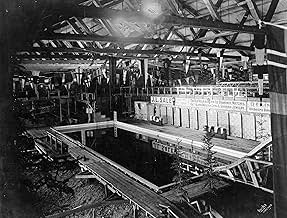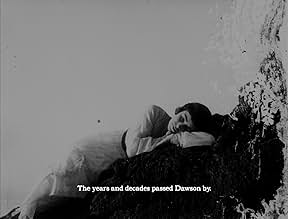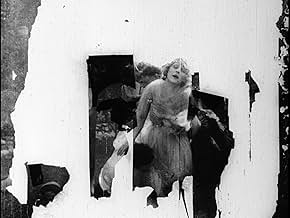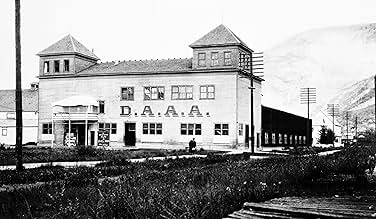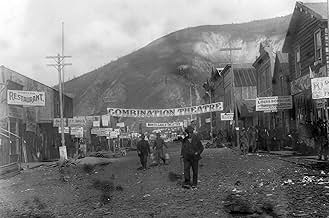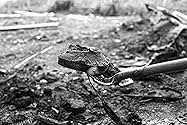Dawson City: Frozen Time
- 2016
- 2 h
AVALIAÇÃO DA IMDb
7,5/10
2,3 mil
SUA AVALIAÇÃO
Adicionar um enredo no seu idiomaThe history of Dawson City, the gold rush town that had a historical treasure of forgotten silent films buried in permafrost for decades until 1978.The history of Dawson City, the gold rush town that had a historical treasure of forgotten silent films buried in permafrost for decades until 1978.The history of Dawson City, the gold rush town that had a historical treasure of forgotten silent films buried in permafrost for decades until 1978.
- Direção
- Roteirista
- Artistas
- Prêmios
- 5 vitórias e 17 indicações no total
Roscoe 'Fatty' Arbuckle
- Self
- (cenas de arquivo)
Frank Barrett
- Self
- (cenas de arquivo)
Alexander Berkman
- Self
- (cenas de arquivo)
Charles Chaplin
- Self as The Lone Prospector
- (cenas de arquivo)
Eddie Cicotte
- Self
- (cenas de arquivo)
Pat Duncan
- Self
- (cenas de arquivo)
Thomas A. Edison
- Self
- (cenas de arquivo)
Chick Gandil
- Self
- (cenas de arquivo)
Chief Isaac of the Tr'ondek Hwech'in Klondike Han
- Self
- (cenas de arquivo)
Larry Kopf
- Self
- (cenas de arquivo)
Kenesaw M. Landis
- Self
- (cenas de arquivo)
- (as Kenesaw Mountain Landis)
Auguste Lumière
- Self
- (cenas de arquivo)
Louis Lumière
- Self
- (cenas de arquivo)
Mary Miles Minter
- Self
- (cenas de arquivo)
Bill Morrison
- Self
- (cenas de arquivo)
Avaliações em destaque
Bill Morrison, the director and writer of Dawson City Frozen Time, is my new hero. Through an odd set of circumstances he landed at the National Archives in Canada and learned about the stash of silent films discovered as part of a landfill site in the Yukon. Early films were made on highly flammable celluloid, and in a new industry (the first film was in 1895 in France) creating an archive was definitely not considered. So, discovering over 500 "lost" silent films from the early 1900's was like discovering gold all over again. (A gold rush was how the city of Dawson initially came into being !!) Mr. Morrison has woven together the story of silent film, the Klondike gold rush and the creation of a city. If you have the opportunity to see this film, please do so. I expect it is going to win a few awards !!
Dawson City, British Columbia is a place where dreams began and dreams ended. Located about 350 miles south of the Arctic Circle, Dawson City was established in 1896 with 3,500 residents and was home to the native Hän speaking people who lived along the Yukon River, harvesting salmon and hunting caribou. As boatloads of gold prospectors arrived from San Francisco and Seattle in 1897, the Native Americans were forced off their land and "relocated" to Klondike City. What happened in between the city's heady gold rush days and its demise has been documented by Bill Morrison ("The Great Flood") in his fascinating film Dawson City: Frozen Time.
Rescued from 533 nitrate reels of film buried for decades beneath an ice rink in Dawson City, Morrison put together a treasure trove of silent films, newsreels, travelogues, and sports footage spanning from 1897 until the 1970s, films once thought lost forever. There is no narration in the film, only subtitles flashed on the screen as unobtrusively as possible along with an insistent score by Alex Somers ("Captain Fantastic"), but it is the images that tell an American story of the connection between money, politics, and entertainment, a connection that brought fame and wealth to some and obscurity to others.
Among the names we recognize who stayed at one time or another in Dawson City were Hän Chief Isaac, Jack London, Fred Trump (Donald's grandfather), Eric Hegg as well as Sid Grauman, Tex Rickard, Klondike Kate, Alexander Pantages, Philadelphia Jack O'Brien, Fatty Arbuckle, Daniel and Solomon Guggenheim, Robert Service, and William Desmond Taylor, names that later became famous in Hollywood. Though the discovery and restoration of the buried reels by Yukon historians Michael Gates and Kathy Jones-Gates took place in 1978, it was not until 2013 that Morrison met with Paul Gordon, film conservator for Library and Archives Canada who agreed to share the collection with a wider audience.
Through the magic of the silent films, we see images of the city turned into a haven for adventurers seeking gold and entertainments in brothels, gambling halls, and theaters. Among the titles bearing witness were "The Frog," "The Birth of a Flower," "A Trip Through Palestine," "The Recoil," and "Polly of the Circus." Even more revealing of the old mindset are such titles as "The Half Breed," "The Female of the Species," "The Hidden Scar," and "The Unpardonable Sin." We see the discovery of gold in Nome, Alaska in 1899 which siphoned off a chunk of Dawson City's population, the end of gambling and prostitution in 1901, and the building of the DAAA, the Dawson Amateur Athletic Association in 1902.
The DAAA was an entertainment center that included a swimming pool, a hockey rink, billiards, boxing and handball and which began showing films that had been brought to Dawson City after having been in circulation for several years. For the reels of film, this was the end of the line. Too dangerous and expensive to return, seventy five percent of the films were lost in fires, purposely burned, or thrown in the Yukon River. The remainder was dumped in the DAAA pool by an employee of the Canadian Bank of Commerce which managed the films.
The burial was made in order to smooth out the ice rink and the reels remained packed in permafrost for fifty years. It was these that were found in 1978, many of them well preserved under the ice, others in various states of decay. In the clips, some that only last a few seconds, Morrison demonstrates through visual poetry how the patterns of deterioration can add themselves to the beauty of the experience.
Among the discoveries was footage of the rigged 1919 World Series, the series commonly known for the infamous Black Sox scandal which Morrison unfortunately seems to justify by pointing out that the players were bound to one team (Reserve Clause) and could not use their performance on the diamond to increase their earnings.
Dawson City: Frozen Time is also not without politically relevant material. Newsreel footage is shown of the 1914 Ludlow Massacre in Colorado where 24 of the 1200 miners on strike against the Colorado Fuel and Iron Company owned by John D. Rockefeller were gunned down by the Colorado National Guard. Judge Kenesaw Mountain Landis, the first baseball commissioner hired to prevent any more Black Sox scandals, used his power to deport socialists who protested World War I and the murder of the miners in Colorado. There is also footage of a black protest parade, and some few words of choice from the corrupt Mayor of New York, Jimmy Walker.
Dawson City: Frozen Time is a snapshot in time of a people thinking big and taking risks, some sadly at the expense of those who had lived there for thousands of years. It is a reminder of an age that has passed, but one whose ramifications have not.
Rescued from 533 nitrate reels of film buried for decades beneath an ice rink in Dawson City, Morrison put together a treasure trove of silent films, newsreels, travelogues, and sports footage spanning from 1897 until the 1970s, films once thought lost forever. There is no narration in the film, only subtitles flashed on the screen as unobtrusively as possible along with an insistent score by Alex Somers ("Captain Fantastic"), but it is the images that tell an American story of the connection between money, politics, and entertainment, a connection that brought fame and wealth to some and obscurity to others.
Among the names we recognize who stayed at one time or another in Dawson City were Hän Chief Isaac, Jack London, Fred Trump (Donald's grandfather), Eric Hegg as well as Sid Grauman, Tex Rickard, Klondike Kate, Alexander Pantages, Philadelphia Jack O'Brien, Fatty Arbuckle, Daniel and Solomon Guggenheim, Robert Service, and William Desmond Taylor, names that later became famous in Hollywood. Though the discovery and restoration of the buried reels by Yukon historians Michael Gates and Kathy Jones-Gates took place in 1978, it was not until 2013 that Morrison met with Paul Gordon, film conservator for Library and Archives Canada who agreed to share the collection with a wider audience.
Through the magic of the silent films, we see images of the city turned into a haven for adventurers seeking gold and entertainments in brothels, gambling halls, and theaters. Among the titles bearing witness were "The Frog," "The Birth of a Flower," "A Trip Through Palestine," "The Recoil," and "Polly of the Circus." Even more revealing of the old mindset are such titles as "The Half Breed," "The Female of the Species," "The Hidden Scar," and "The Unpardonable Sin." We see the discovery of gold in Nome, Alaska in 1899 which siphoned off a chunk of Dawson City's population, the end of gambling and prostitution in 1901, and the building of the DAAA, the Dawson Amateur Athletic Association in 1902.
The DAAA was an entertainment center that included a swimming pool, a hockey rink, billiards, boxing and handball and which began showing films that had been brought to Dawson City after having been in circulation for several years. For the reels of film, this was the end of the line. Too dangerous and expensive to return, seventy five percent of the films were lost in fires, purposely burned, or thrown in the Yukon River. The remainder was dumped in the DAAA pool by an employee of the Canadian Bank of Commerce which managed the films.
The burial was made in order to smooth out the ice rink and the reels remained packed in permafrost for fifty years. It was these that were found in 1978, many of them well preserved under the ice, others in various states of decay. In the clips, some that only last a few seconds, Morrison demonstrates through visual poetry how the patterns of deterioration can add themselves to the beauty of the experience.
Among the discoveries was footage of the rigged 1919 World Series, the series commonly known for the infamous Black Sox scandal which Morrison unfortunately seems to justify by pointing out that the players were bound to one team (Reserve Clause) and could not use their performance on the diamond to increase their earnings.
Dawson City: Frozen Time is also not without politically relevant material. Newsreel footage is shown of the 1914 Ludlow Massacre in Colorado where 24 of the 1200 miners on strike against the Colorado Fuel and Iron Company owned by John D. Rockefeller were gunned down by the Colorado National Guard. Judge Kenesaw Mountain Landis, the first baseball commissioner hired to prevent any more Black Sox scandals, used his power to deport socialists who protested World War I and the murder of the miners in Colorado. There is also footage of a black protest parade, and some few words of choice from the corrupt Mayor of New York, Jimmy Walker.
Dawson City: Frozen Time is a snapshot in time of a people thinking big and taking risks, some sadly at the expense of those who had lived there for thousands of years. It is a reminder of an age that has passed, but one whose ramifications have not.
A documentary that tries to do just a little too much. The story itself is fascinating - the discovery in 1978 of a trove of lost silent films preserved in the permafrost of Dawson City, Canada. To me, the 'star of the show' in the documentary needs to be the films, and I would have liked the focus to be there, after an introductory explanation of context. Instead, director Bill Morrison rewinds us all the way back through the history of Dawson, from its founding, the Yukon gold rush, and the subsequent changes to the town over the years. He also takes us through various news stories and social movements from the 1910's and 1920's, as they relate to footage that was discovered.
I like history and some of this was interesting to me, and at its best he matches photos to footage (for example, a socialist agitator being deported back to Russia). At its worst he gets into minutiae of Dawson's history, and instead of just showing some number of the silent films fragments themselves with explanation of the actors, attempts to match footage to what people in the present are talking about. For example, one of the discoverers of the trove says he had to call someone up to come have a look at it, so as he's describing that, we see footage of someone on the phone in an old movie. The background music is awfully eerie and odd in places too. It was interesting enough to watch and a lot of research and care went into the production, so depending on your interests, you may like it better.
I like history and some of this was interesting to me, and at its best he matches photos to footage (for example, a socialist agitator being deported back to Russia). At its worst he gets into minutiae of Dawson's history, and instead of just showing some number of the silent films fragments themselves with explanation of the actors, attempts to match footage to what people in the present are talking about. For example, one of the discoverers of the trove says he had to call someone up to come have a look at it, so as he's describing that, we see footage of someone on the phone in an old movie. The background music is awfully eerie and odd in places too. It was interesting enough to watch and a lot of research and care went into the production, so depending on your interests, you may like it better.
10suzy-63
This is a must see documentary. It is a fascinating story of both the gold rush and the silent film era. As a film buff I was impressed by the story telling that included photos, film footage of that era and the film that was recovered in Dawson City. The music score blended perfectly with the story telling. This film has "Best Documentary" Oscar written all over it.
At first, I thought this was an okay film.10 minutes later I thought it was very good. 10 minutes after that, I realized it was excellent. The pace is slow, deliberate, and has more than its share of "Holy cow!" moments. Be patient as there's a huge story that needs to be told and it has a cast of thousands. Using old movie footage (from films both preserved in Hollywood and "found" in Dawson City) and interviews with some of the people "who were there", Bill Morrison has crafted a big story of a small town in a very big world with history playing out all around it.
An extraordinary piece of documentary film-making. Bravo!
An extraordinary piece of documentary film-making. Bravo!
Você sabia?
- CuriosidadesThe film contains rare footage of the 1919 World Series - known for the Black Sox betting scandal.
- ConexõesFeatures Le débarquement du congrès de photographie à Lyon (1895)
- Trilhas sonorasFlutter
(uncredited)
Written and Produced by Alex Somers
Performed by Alex Somers,Birgir Jón Birgisson , Edda Rún Ólafsdóttir, Hildur Ársælsdóttir, María Huld Markan Sigfúsdóttir, Samuli Kosminen and Sólrún Sumarliðadóttir
Mastered by Taylor Deupree
Krunk
Principais escolhas
Faça login para avaliar e ver a lista de recomendações personalizadas
- How long is Dawson City: Frozen Time?Fornecido pela Alexa
Detalhes
Bilheteria
- Faturamento bruto nos EUA e Canadá
- US$ 132.369
- Faturamento bruto mundial
- US$ 132.369
- Tempo de duração
- 2 h(120 min)
- Cor
- Proporção
- 1.33 : 1
Contribua para esta página
Sugerir uma alteração ou adicionar conteúdo ausente




